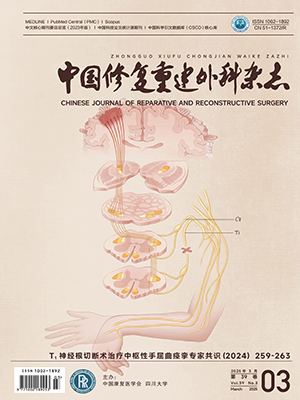| 1. |
Guerin P, EI Fegoun AB, Obeid I, et al. Incidental durotomy during spine surgery:incidence, management and complications. A retrospective review. Injury, 2012, 43(4):397-401.
|
| 2. |
Strömqvist F, Jönsson B, Strömqvist B, et al. Dural lesions in lumbar disc herniation surgery:incidence, risk factors, and outcome. Eur Spine J, 2010, 19(3):439-442.
|
| 3. |
Lotfinia I, Sayyahmelli S. Incidental durotomy during lumbar spine surgery. Neurosurgery Quarterly, 2012, 22(2):105-112.
|
| 4. |
Joseph V, Kumar GS, Rajshekhar V. Cerebrospinal fluid leak during cervical corpectomy for ossified posterior longitudinal ligament:incidence, management, and outcome. Spine (Phila Pa 1976), 2009, 34(5):491-494.
|
| 5. |
Raffa SJ, Benglis DM, Levi AD. Treatment of a persistent iatrogenic cerebrospinal fluid-pleural fistula with a cadaveric dural-pleural graft. Spine J, 2009, 9(4):e25-e29.
|
| 6. |
Bachmann G, Djenabi U, Jungehülsing M, et al. Incidence of occult cerebrospinal fluid fistula during paranasal sinus surgery. Arch Otolaryngol Head Neck Surg, 2002, 128(11):1299-1302.
|
| 7. |
Cho JY, Chan CK, Lee SH, et al. Management of cerebrospinal fluid leakage after anterior decompression for ossification of posterior longitudinal ligament in the thoracic spine:the utilization of a volume-controlled pseudomeningocele. J Spinal Disord Tech, 2012, 25(4):E93-E102.
|
| 8. |
Washburn EW. The dynamics of capillary flow. Physical Review, 1921, 17(3):273-283.
|
| 9. |
Pirofsky B. The determination of blood viscosity in man by a method based on Poiseuille's law. J Clin Invest, 1953, 32(4):292-298.
|
| 10. |
Volobuev AN, Tolstonogov AP. Features of viscous-fluid flow in an elastic pipeline. Journal of Engineering Physics and Thermophysics, 2009, 82(4):749-755.
|
| 11. |
Srivastava A, Sood A, Joy SP, et al. Principles of physics in surgery:the laws of flow dynamics physics for surgeons-Part 1. Indian J Surg, 2009, 71(4):182-187.
|
| 12. |
Reddick AD, Ronald J, Morrison WG. Intravenous fluid resuscitation:was Poiseuille right? Emerg Med J, 2011, 28(3):201-202.
|
| 13. |
McPherson D, Adekanye O, Wilkes AR, et al. Fluid flow through intravenous cannulae in a clinical model. Anesth Analg, 2009, 108(4):1198-1202.
|
| 14. |
Song D, Park P. Primary closure of inadvertent durotomies utilizing the U-Clip in minimally invasive spinal surgery. Spine (Phila Pa 1976), 2011, 36(26):E1753-E1757.
|
| 15. |
Clendenen SR, Pirris S, Robards CB, et al. Symptomatic postlaminectomy cerebrospinal fluid leak treated with 4-dimensional ultrasound-guided epidural blood patch. J Neurosurg Anesthesiol, 2012, 24(3):222-225.
|
| 16. |
Tosun B, Ilbay K, Kim MS, et al. Management of persistent cerebrospinal fluid leakage following thoraco-lumbar surgery. Asian Spine J, 2012, 6(3):157-162.
|
| 17. |
Tafazal SI, Sell PJ. Incidental durotomy in lumbar spine surgery:incidence and management. Eur Spine J, 2005, 14(3):287-290.
|
| 18. |
Hawk MW, Kim KD. Review of spinal pseudomeningoceles and cerebrospinal fluid fistulas. Neurosurg Focus, 2000, 9(1):e5.
|
| 19. |
Shapiro SA, Scully T. Closed continuous drainage of cerebrospinal fluid via a lumbar subarachnoid catheter for treatment or prevention of cranial/spinal cerebrospinal fluid fistula. Neurosurgery, 1992, 30(2):241-245.
|
| 20. |
Kitchel SH, Eismont FJ, Green BA. Closed subarachnoid drainage for management of cerebrospinal fluid leakage after an operation on the spine. J Bone Joint Surg (Am), 1989, 71(7):984-987.
|




